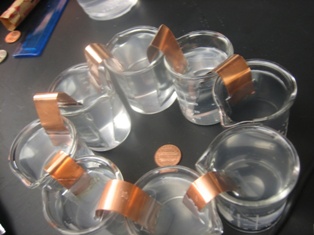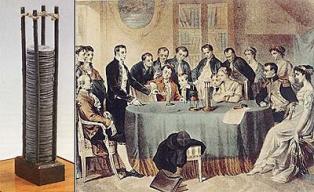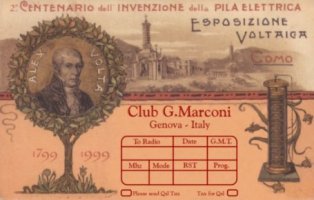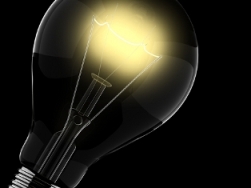From the history of the "metallic" electricity, open Volta
When Volta invented the electrochemical cell, he was faced with the question: what is the cause of electric current - in contact of the two metals or metal in contact with liquids?
Volta tried to remove all liquid and put this experience. On a sensitive electroscope was placed copper disk topped with a thin insulating layer. On it put a zinc disk with insulating handle and the two disc momentarily joined copper wire. the wire is then removed and the upper disc removed. Electroscope showed the presence of the charge. Volta explained this experience is. When two dissimilar metal brought in contact, they had opposite charges. However, these charges are attracting each other, remain on either side of the insulator. When the upper disc removed charged, the charges from the lower disc hit the electroscope petals. And while no liquid was not.
Consequently, the whole thing just touching the two metal! But with the metals themselves with absolutely nothing happened except the occurrence of charge. So, as claimed by Volta, he managed to open the source of electric current, which can operate only on the metal contact, without changing or expending them.

There was only one "small detail": Unfortunately, the zinc electrode in galvanic cells for some reason all the time oxidized zinc oxide and interrupt current. The electrodes have to be cleaned. Volta was always trying to make the best design galvanic cells, but could not get rid of the appearance of oxide. Nevertheless, he was confident that the problem is solvable in principle and he realized dream - to create a perpetual motion machine!
After the discovery of the law of conservation of energy and physics electrochemists subjected to sharp criticism the views of the Volta. There can be no electric current and generate heat without any energy input! It may not occur only on the electrical phenomena of contact of the two metals; air always has bet on metals which settle and oxidize them. Volta discovered not "metal" electricity, and "chemical" electricity - as in its chemical energy into electrical elements of the transition, because something and oxidized zinc!
See how remarkable accuracy repeats the whole story with Galvani.

Galvani discovered actually "metallic" electricity, and thought that he had discovered "animal electricity", - said Volta. Underlying error Galvani was lying that he did not pay attention to important facts that contradict his theory - the need for the presence of two different metals (or rather, drew attention, but did not attach due importance to the fact). Volta discovered "chemical" electricity, and thought that he had discovered "metal" electricity - Ostwald writes in his "History of electrochemistry." Volta did not pay attention to important facts that contradict his theory of perpetual motion - the oxidation of the electrodes, or rather, did not attach due importance to it.
But the interesting thing was that it was right and Galvani, Volta and his critic, just as was right and the Volta, and his critic Ostwald.
In fact Galvani discovered two different phenomena - and "animal electricity", and metal. But he believed that he had discovered only the first of them, and Volta believed that there is only the second. Similarly, Volta discovered two different phenomena - contact potential difference arising upon contact of the two metals, and chemical current sources. But the Volta believed that only the first discovered the phenomenon, while its critic Ostwald recognized only the second. (The difficulty to distinguish between several phenomena occur simultaneously or in similar experiments in chem-to - very typical situation in science, and we with it more than once face.) Only the further course of the development of science has shown, what was right and what is wrong Galvani Volta and Ostwald.

After Volta invented the electrochemical cell and physics received a constant current source, it began the rapid development of electrodynamics, stimulated by a number of practical applications of electric current. This eventually allowed to find out the truth of Galvani.
Already in 1800, the thermal effect of the current was discovered in 1803 published a book about Petrov voltaic arc. In 1820 Oersted discovered the action of electric current on a magnetic needle, linking sections of the science of electricity and magnetism, that have evolved separately. And within a year (that's more proof that the practical use of non-lagged!) Followed by the remarkable development of this discovery.
Amp puts forward the idea of the electromagnetic telegraph, Barlow and Faraday manufactured the first primitive models of electric motors, and Schweiger invents galvanometer - a device for measuring DC current. Finally, there was an objective way to measure small currents, which were previously recorded only using frog legs.
Galvanometer Schweiger was based on the action of the coil with a current on a magnetic needle, but he was sensitive to the magnetic field and the Earth, which is prevented accurate measurements.
In 1821 Ampere proposed to strengthen on the same axis two magnetic arrows so that their opposite poles are arranged one above the other, it is possible to get rid of the influence of the magnetic field of the Earth. Schweiger first insulated wire with wax or wax, but after a few years in connection with the creation of the telegraph wires were insulated with silk. In the hands of physicists it was quite reliable and sensitive measuring instrument.
In 1826-1827 gg. German physicist G. Ohm discovered the law that bears his name. For electrobiology it was particularly important that Ohm introduced the concept of "amperage", "resistance", which lacked Galvani and Volta.

In 1825, the Florentine physicist L. Nobili has created a highly sensitive galvanometer, and in 1827 with the help of this instrument for the first time he was able to register the difference in potential between various points of the frog's body. But, as we have said, just put the experience is not enough, we must also understand it correctly.
Nobili was a follower of the Volta, and thus explained the emergence of a potential registered the fact that some areas of tissue warmer than the other, since the rate of evaporation of the liquid from the different points can not be strictly identical. So Nobili passes important otkrytiya.Avtoritet Volta prevented him no less than the credibility of Gilbert prevented Galvani.
Since 1837 another Italian scientist, K. Matteucci uses a galvanometer to objective verification experiments of Galvani and his followers.
First of all, Matteucci found that between intact (whole) and muscle damage sites have potential difference; while muscle incision always plays the role of a negative pole. The current flowing to the damaged area, called a fault current. This result Matteucci gave an explanation of the first two experiments of Galvani, and because Galvani assumed that between intact and damaged portions of the muscles flowing electric fluid. However, Matteucci was able to register only the current muscle damage, but not the nerve (lacked the sensitivity of the instrument). But if we assume that a similar situation for the damaged nerve, then it is clear that the place of the cut nerve served as a source of power, which in the first experiment aroused muscle of the frog, and the second - its nerve.
Matteucci found that somehow ebbed during the excitation current of the damaged muscle damage. It really surprised experimenter. It would seem that when excited it should increase, rather than decrease!
Finally, Matteucci made the third well-known experiment of Galvani. Matteucci showed directly that the excitation of the muscles intact between its parts is an electric current that can excite the nerve lying on it. Matteucci works were fundamental in nature: to them, is the only measuring device itself served as a foot of the frog, there was no certainty that the excitation processes are related to electrical phenomena.
After work Matteucci it could be considered proven. Recall that all this happened in 1837. It was the year of the centenary of the birth year of Galvani and his posthumous triumph. It has proved the correctness of the explanation of his past experiences. Already in 1841, there is a complete collection of the works of Galvani. Galvani again becomes famous, and now forever.
Berkinblit MB, Glagoleva EG "Electricity in living organisms"


Comments
Commenting, keep in mind that the content and the tone of your messages can hurt the feelings of real people, show respect and tolerance to his interlocutors, even if you do not share their opinion, your behavior in terms of freedom of speech and anonymity offered by the Internet, is changing not only virtual, but real world. All comments are hidden from the index, spam control.